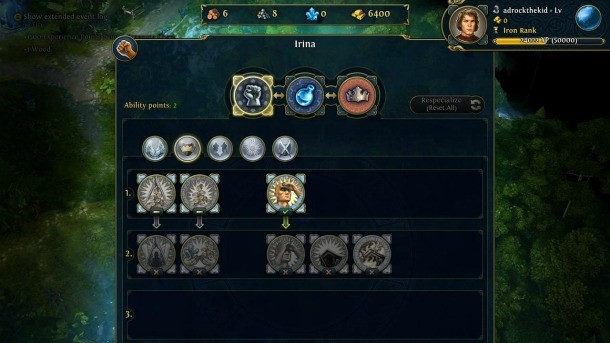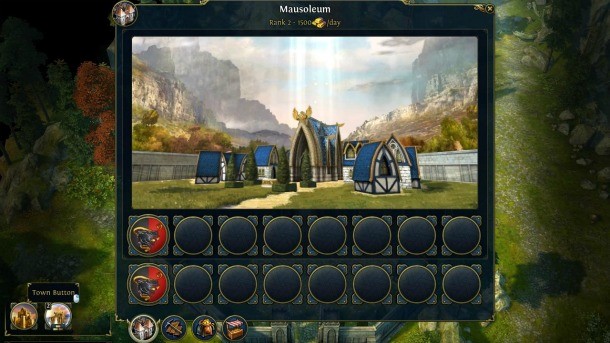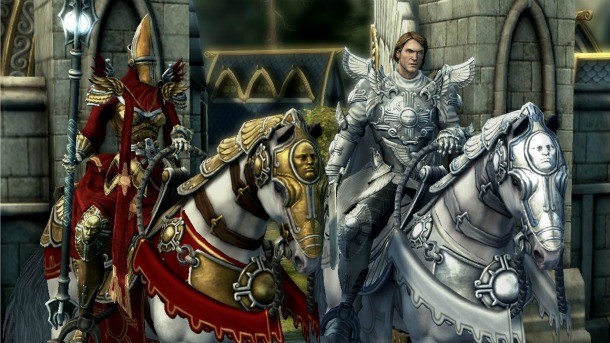Might & Magic Heroes VI

Might & Magic Heroes VI is a slight rebranding of the decades-old Heroes of Might & Magic franchise, and the change in image is accompanied by a re-examination of the building blocks of the series. Heroes VI is still about powerful heroes leading massive armies of fantastical creatures into turn-based battle, but digging into the closed beta has proven that many of the details beyond that broad description have been re-examined and rewritten for this entry.
Heroes VI, like its predecessors, is a turn-based strategy game that takes place on a simple 2D map dotted with neutral armies, piles of resources, wealth-granting mines, and towns and forts to fight over. Your heroes move from site to site gathering riches, gaining experience, recruiting new troops, and invading your enemies. Unlike many grand strategy titles, armies only move in huge stacks led by the titular heroes.
Much of the game’s combat is against the neutral guardians that protect the many goodies you’re racing your opponents for control of. These tactical battles are as big a part of the game as the overworld strategy layer, and the spectacular variety of creatures, spells, and effects really shines in these turn-based contests.
While the first four games and their many expansions largely built onto the core mechanics introduced in the very first Heroes of Might & Magic game (and King’s Bounty before that, which has since splintered off into an excellent Russian-developed alternate series), Heroes VI changes a lot of things that were previously thought untouchable. Read on for the most significant of the radical changes coming in the second Heroes title since Ubisoft has taken over the Might & Magic franchise.

Go big or go home. Heroes VI features dozens of freestanding buildings on the map that give various bonuses, from mines that ship resources into your kingdom’s treasury to dwellings that bolster your weekly creature recruitment. Unlike previous installments, these can’t be taken over by simply moving a hero on top of them. The map is divided into control zones, each of which corresponds with a town or a fort. The owner of the province’s seat reaps all the rewards for any mines and dwellings in the area except those actively occupied by an enemy stack, so as long as you can hold onto the fort you’re largely immune to harassment from enemy heroes.
The good news: You don’t have to hunt down an endless stream of weenie heroes running into your territory, jacking your mines with only a few creatures that have no hope of doing non-trivial damage in any battle with a real army. This change definitely pushes matches toward clashes between opponents’ main armies, which is great.
The bad news: You can get stuck in a stalemate where you’re strong enough to beat your opponents in an even battle, but not so powerful that you can win a siege battle against an emplaced army. In other Heroes games, you could run around and grab his mines while he cowered in his castle, gaining a resource advantage. Stealing a single mine’s output by sitting on it is not nearly as effective.

Choose your own path to power. Heroes VI gives each and every hero access to the full skill tree to progress down how the player sees fit, instead of the random increase to primary stats and choice between two abilities of older games.
The good news: You’ll never be stuck choosing between Mysticism (bad) and Eagle Eye (terrible) again.
The bad news: The Might, Magic, and Realm tabs each have several skill pages apiece, all of which have a handful of abilities to choose from. There’s just too much crap to sort through. The very randomness that could be irritating at times was also a blessing. It forced you to play the hand you were dealt, which gave rise to interesting builds to experiment with.

So much fluff has been trimmed. Heroes III (the zenith of the old Heroes design in most fans’ eyes) had so much variety that it was daunting to keep track of, between seven tiers of creature in every faction, dozens of spells, and more. Heroes VI chops away a lot of the extraneous design in search of a streamlined experience. Factions have only three tiers of creature, though there are multiple unit types in each tier. Spells are gained by choosing them at level-up, not by random draw in Mages’ Guilds (which no longer exist). Most of the special resources have been cut, leaving only gold, wood, ore, and crystal.
The good news: Did you really enjoy making sure you had mercury, sulfer, gems, and crystal all coming in? I sure didn’t. The new design behind army composition sacrifices nothing in variety -- in fact, the creatures I’ve played with so far encouraged more interesting tactics with their abilities -- but simplifies the basic mental math involved in eyeballing power levels. And you’ll never have an air-focused mage who can’t get a freaking mage guild to spawn a freaking lightning bolt spell.
The bad news: On the creature front, I have no concerns -- everything I’ve seen so far is great. Spell-wise I’m bummed at losing the breadth of magic available in Heroes III, but realistically you’d only ever cast the few best spells in whatever school of magic you were specialized in anyway, so at least you know you’ll have the core spells you need now.

The little things got attention too. Heroes is a huge, complex game even with the streamlining for this installment. I’ve been pleased at a lot of minor changes to the game, like truly outstanding in-game documentation through tooltips -- almost everything in the game can be right-clicked or moused over for additional information. As mentioned above, the creature sets I’ve seen promote creative tactical thinking (even if some of them badly need a balance pass), from the Haven’s footsoldiers who guard adjacent allies from incoming damage to the Sanctuary’s naga warriors and their passive “challenge” ability that forces their target to attack them or lose a significant portion of their damage.
The big question: multiplayer. Ubisoft is building something called the Conflux for Heroes VI. It ties into the meta-progression of your “dynasty,” but I can’t tell exactly what that entails as it’s only marginally enabled in the current closed beta. Every time a hero gains experience, that XP also goes into a catch-all pool tied to your personal profile -- though I haven’t seen what ranking up your profile accomplishes yet. It’s easy to guess that Ubisoft is trying to push something akin to the persistent progression that keeps players coming back to Call of Duty online play after thousands of hours, but the specifics of how it works are unclear. Apparently there’s something called an Altar of Wishes that gives you stuff, and achievements to show off to your friends, and dynasty weapons that follow your heroes across scenarios, but we’ll have to wait and see. However it shakes out, I can say that I love the fact that my favorite genre is finally catching up on this front.

As a Heroes of Might & Magic superfan, I’m pretty happy overall. Any number of things could go wrong in advance of the game’s September 6 release, from crappy AI (Heroes V’s big downfall) to crappy scenario design (hi again, Heroes V!) or an overall lack of polish (Heroes IV being pushed out the door to stave off 3D0’s impending bankruptcy was a terrible tragedy), but I’m encouraged by what I’ve seen so far. The design changes are a net positive in my book, and if Black Hole Entertainment and Ubisoft can build a good game around them, I’m there.








Get the Game Informer Print Edition!
Explore your favorite games in premium print format, delivered to your door.
- 10 issues per year
- Only $4.80 per issue
- Full digital magazine archive access
- Since 1991










